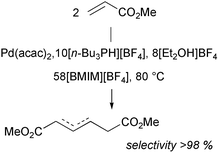Acrylate dimerisation under ionic liquid–supercritical carbon dioxide conditions†
Abstract
Ionic liquid 1-n-butyl-3-methylimidazolium tetrafluoroborate and supercritical CO2 have been used for the biphasic palladium-catalysed dimerisation of methyl acrylate. Substrate and product distribution between the two phases and extraction capability of scCO2 are evaluated. The effect of the biphasic medium on the catalyst performance is also addressed. The selectivity for the tail-to-tail dimers is >98%, as high as under monophasic conditions. The same trend stands for turnover number and frequency although there is a lower substrate to palladium ratio in the IL phase. The CO2-rich phase acts as a substrate and product reservoir, a suitable case for studying the reaction under continuous feed and extraction regime.


 Please wait while we load your content...
Please wait while we load your content...